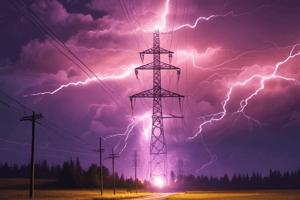Podcast
Questions and Answers
What is the primary function of a lightning rod?
What is the primary function of a lightning rod?
- To provide an easier path for lightning to reach the ground (correct)
- To attract lightning to the building
- To generate electricity for the building
- To prevent rain from falling on the building
Lightning rods are made of plastic or wood.
Lightning rods are made of plastic or wood.
False (B)
What materials are commonly used to make lightning rods?
What materials are commonly used to make lightning rods?
Iron or copper
A lightning rod connects to the ground through a ________.
A lightning rod connects to the ground through a ________.
Match the following components with their functions in a lightning protection system:
Match the following components with their functions in a lightning protection system:
What is the charge of a neutron?
What is the charge of a neutron?
An atom with more electrons than protons is known as a cation.
An atom with more electrons than protons is known as a cation.
Where are protons located in an atom?
Where are protons located in an atom?
An atom becomes positively charged when it has more ______ than ______.
An atom becomes positively charged when it has more ______ than ______.
Match the following particles with their respective properties:
Match the following particles with their respective properties:
Which material has a greater tendency to gain electrons when rubbed against human skin?
Which material has a greater tendency to gain electrons when rubbed against human skin?
When two materials are rubbed together, the one higher on the electrostatic series becomes negatively charged.
When two materials are rubbed together, the one higher on the electrostatic series becomes negatively charged.
What occurs when a negatively charged object comes into contact with a neutral object?
What occurs when a negatively charged object comes into contact with a neutral object?
The electrostatic series ranks materials based on their tendency to gain __________.
The electrostatic series ranks materials based on their tendency to gain __________.
Match the following materials with their expected charge tendency when rubbed against skin:
Match the following materials with their expected charge tendency when rubbed against skin:
What main property defines static electricity?
What main property defines static electricity?
Like charges attract each other.
Like charges attract each other.
Define static electricity in your own words.
Define static electricity in your own words.
An object becomes positively charged by losing ________.
An object becomes positively charged by losing ________.
Match the type of charge with its definition:
Match the type of charge with its definition:
What happens during charging by conduction between two charged objects?
What happens during charging by conduction between two charged objects?
Grounding can neutralize both positively and negatively charged objects.
Grounding can neutralize both positively and negatively charged objects.
Describe what occurs when a negatively charged object is grounded.
Describe what occurs when a negatively charged object is grounded.
An example of a product that uses charging by friction to attract dust is an ________ duster.
An example of a product that uses charging by friction to attract dust is an ________ duster.
Match the following electrical concepts with their descriptions:
Match the following electrical concepts with their descriptions:
What happens to the side of the pith ball that is closest to the negatively charged ebonite rod?
What happens to the side of the pith ball that is closest to the negatively charged ebonite rod?
Grounding the negatively charged side of the pith ball prevents it from becoming positively charged.
Grounding the negatively charged side of the pith ball prevents it from becoming positively charged.
What is the purpose of disconnecting the ground before removing the charged object?
What is the purpose of disconnecting the ground before removing the charged object?
An electrostatic lifting apparatus can be used to copy ________ at a crime scene.
An electrostatic lifting apparatus can be used to copy ________ at a crime scene.
Match the components of an electrostatic speaker:
Match the components of an electrostatic speaker:
Flashcards
Lightning Rod
Lightning Rod
A pointed metal rod attached to a building, providing a safe path for lightning to travel to the ground.
How does a lightning rod work?
How does a lightning rod work?
Lightning rods use their pointed shape to attract lightning strikes. The electricity then flows down a wire connected to the ground, preventing damage to the building.
What is the main conductor?
What is the main conductor?
The wire that connects the lightning rod to the ground, allowing lightning to flow safely into the earth.
Electric Discharge
Electric Discharge
Signup and view all the flashcards
What are lightning rods usually made of?
What are lightning rods usually made of?
Signup and view all the flashcards
Electrostatic Series
Electrostatic Series
Signup and view all the flashcards
Triboelectric Effect
Triboelectric Effect
Signup and view all the flashcards
Charging by Conduction
Charging by Conduction
Signup and view all the flashcards
How does the electrostatic series predict charge transfer?
How does the electrostatic series predict charge transfer?
Signup and view all the flashcards
What happens when a negatively charged object touches a neutral object?
What happens when a negatively charged object touches a neutral object?
Signup and view all the flashcards
Powder Coating
Powder Coating
Signup and view all the flashcards
Electrostatic Charge in Powder Coating
Electrostatic Charge in Powder Coating
Signup and view all the flashcards
Environmental Benefits of Powder Coating
Environmental Benefits of Powder Coating
Signup and view all the flashcards
Static Electricity
Static Electricity
Signup and view all the flashcards
Law of Electric Charges
Law of Electric Charges
Signup and view all the flashcards
Charging by Induction Defintion
Charging by Induction Defintion
Signup and view all the flashcards
How does Induction Charge Objects?
How does Induction Charge Objects?
Signup and view all the flashcards
Electrostatic Lifting Apparatu
Electrostatic Lifting Apparatu
Signup and view all the flashcards
Electrostatic Speaker
Electrostatic Speaker
Signup and view all the flashcards
What is the difference between charging by induction and conduction?
What is the difference between charging by induction and conduction?
Signup and view all the flashcards
Grounding
Grounding
Signup and view all the flashcards
How does grounding work with a positive charge?
How does grounding work with a positive charge?
Signup and view all the flashcards
How does grounding work with a negative charge?
How does grounding work with a negative charge?
Signup and view all the flashcards
Electrostatic Dusters
Electrostatic Dusters
Signup and view all the flashcards
Atom's building blocks
Atom's building blocks
Signup and view all the flashcards
Where are protons & neutrons?
Where are protons & neutrons?
Signup and view all the flashcards
Electrically neutral atom
Electrically neutral atom
Signup and view all the flashcards
What are ions?
What are ions?
Signup and view all the flashcards
Positive and negative objects
Positive and negative objects
Signup and view all the flashcards
Study Notes
Lightning Rods
- Lightning rods are common on homes and barns in the country
- Large open areas make buildings more vulnerable to lightning strikes
- Lightning rods direct lightning into the ground.
- A lightning rod is usually made of metal, such as iron or copper.
- There is also a wire that goes from the rod into the ground.
- This protects the building from being struck by lightning.
Electric Discharge
- An electric discharge is the rapid transfer of electrons
- Electric discharges can produce visible sparks.
- Lightning is a visible and dramatic example of an electric discharge.
- Lightning rods are used to safely direct lightning into the ground.
- Lightning strikes may occur between a cloud and the ground or between two clouds and the ground.
- The excess negative charge at the bottom of the cloud repels the electrons at Earth’s surface
Studying That Suits You
Use AI to generate personalized quizzes and flashcards to suit your learning preferences.
Description
Test your knowledge on the principles of electrostatics and the functions of lightning protection systems. This quiz covers topics such as lightning rods, atomic structure, and the behavior of charged particles. Perfect for students studying physics or related subjects.




